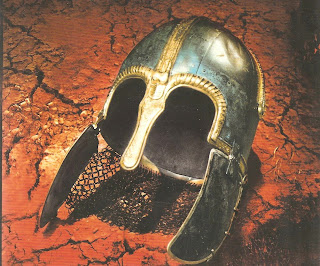I'm in love with Bernard Cornwell . . .

What makes a book set in 9th century England interesting - even riveting - to a 21st century female peacenik reader? The work is full of ship lore and men gutting each other with swords and axes, brutality, treachery, and an ailing King Alfred who is presented as a pitiful figure. The protagonist, Uhtred, is a raging Viking warlord with a grudge against Christians. Uhtred is full of pride and bombast; he treats women as chattels, unless he loves them; and he utterly enchants me!
Cornwell takes the bleak setting of English marshes and bald hills and sloggy winter rains and creates a motion picture in words of the land the reader can “see”: rude villages with thatched huts, cowering peasants, often caught between two warring armies, magnificent armor, larger-than-life men. Life in the 9th century and the setting itself is part of the story. Cornwell is a meticulous researcher, and when he describes a scene I revel in every detail:
Morning, and I was young, and the sea was a shimmer of silver and pink beneath wisps of mist that obscured the coasts.
Cornwell’s prose reads like poetry. I suspect he is an admirer of Norse and Icelandic sagas, which were meant to be half-recited, half-sung and accompanied by a harper, in the lord’s hall.
Now, on that distant morning when I was still young, we rowed eastwards on that pink and silver sea.
I can’t resist language like that. Even Cornwall’s descriptions of battle stir me to my toes:
We were screaming a great shout of defiance. My shield, iron-rimmed, was heavy on my left arm. Wasp-Sting was drawn back . . . .The horsemen slammed into the Danes...horses were fetlock deep in blood, and still the swords and axes crushed and cut.
I aimed for Harald himself. He wore no helmet, relying on the sun-glistening blood to terrify his enemies, and he was terrifying: a big man, snarling, eyes wild, ropy-hair dripping red, his shield painted with an axe blade and a short-hafted, heavy-bladed war axe as his chosen weapon.
This is a saga of the struggle for land and power and religious dominance among Anglo Saxons, Mercians, and Danes, written so the reader shudders in revulsion. Descriptions are terrifyingly vivid. [Horse-lovers, do not read this!]
Harald faced us, huge in cloak and mail, then spread his arms as though crucified, and in his right hand was a massive battle axe with which, after bellowing that we would all be fed to the slime worms of death, he killed the horse. He did it with one stroke of the axe and, while the beast was still twitching in its death throes, he slit open its belly and plunged his unhelmeted head deep into the bloody entrails.
My men watched in silence. Harald, ignoring the spasms of the hooves, held his
head deep in the horse’s belly, then stood and turned to show a blood-masked face
and blood-soaked hair and a thick beard dripping with blood. Harald Bloodhair
was ready for battle.”
Yet in the midst of the electrifying tale of struggle and death, Cornwell can portray great gentleness and sensibility:
I took Skade beneath the steering platform, to the small space there, and I took off her cloak and I lay her down, and when we were done we were both in tears.
I met Bernard Cornwell, at a Historical Novel Society conference in 2007. He is tall, attractive, kind of rugged-looking, with scholarly-looking glasses, and nice smile and a warm voice. He speaks well. He writes beautifully. And every time I read one of his books I am smitten all over again.
Quotation source: Bernard Cornwell, The Burning Land, 2009.


Comments
Post a Comment